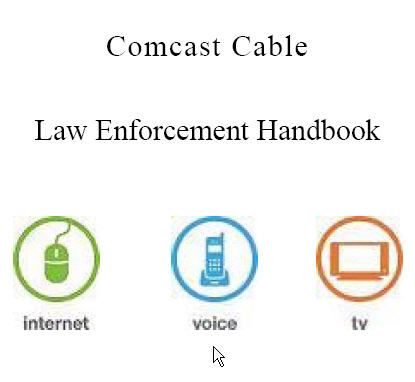Revealed: Comcast Digital Voice's policy for customer records requests from law enforcement

An internal Comcast document entitled Comcast's Handbook for Law Enforcement reveals the manner in which the cable and broadband giant keeps phone records of its Comcast Digital Voice customers.
Not only does a look at this document reveal those matters, but it also discloses Comcast's policies for responding to requests from law enforcement for selected records of these customers.
The Handbook has been published on the website of the Federation of American Scientists. It tells a lot about how these records can go from Comcast's deep, dark digital vaults to the hands and eyes of law enforcement and- by-implication, terror-investigator agencies and the like.
Follow along, and I will show you the relevant sections:
Subscriber Account Identification and Related Records
For identification based upon telephone number:Comcast can only provide account information on telephone numbers with which we currently or have historically provided service. The current company which provides service to a specific telephone number can be obtained by contacting Neustar. Neustar is the company which serves as the FCC-appointed administrator of the North American Numbering Plan (NANP). To obtain provider information from Neustar, you must first have an account active at Neustar. Neustar’s website is www.neustar.biz and the NANP website is http://www.nanpa.com/.
For identification based upon a person’s name:
Comcast cannot identify a subscriber based upon a name alone. It is necessary to include the street address where it is believed the individual receives service. It may be possible in some cases to identify a subscriber based on name and a city and state (with no street address).
Comcast will only respond to a request for identification based on the name exactly as it is written on the request. For example: if the request asks for information relating to James Doe in Springfield and Comcast’s records reveal a J. Doe and/or a Jim Doe in Springfield, Comcast will not have information responsive to the request or may require additional legal process to determine if it has responsive information. If initials or nickname are used you should add a request for those other versions of the name in your legal request.
For identification based upon a street address:
It is necessary to provide an entire street address. In the request, please supply the house or apartment number, the street name, the city, state, and the zip code of the location you have targeted.
Over a length of time it is possible that Comcast has supplied service to multiple customers at the same address. Therefore, it is necessary to narrow a search for customer identity to a specific period of time.
For identification based upon a Comcast account number:
Please provide a complete account number. Legal requests with incomplete account numbers will not result in successful identifications.
Retention Policies
Call Detail RecordsComcast maintains two years of historical call detail records (records of local and long distance connections) for our Comcast Digital Voice telephone service. This includes local, local toll, and long distance records. Comcast also currently provides traditional circuit-switched telephone service branded Comcast Digital Phone. Call detail records for this service are collected by AT&T and are available for approximately two years as well.
To determine which type of service is involved, contact the Legal Demands Center—Voice and Video at 800-871-6298.
Account Records
Account records are generally stored for approximately two years after the termination of an account. If the account has an outstanding balance due, records may be retained for a longer period of time.
